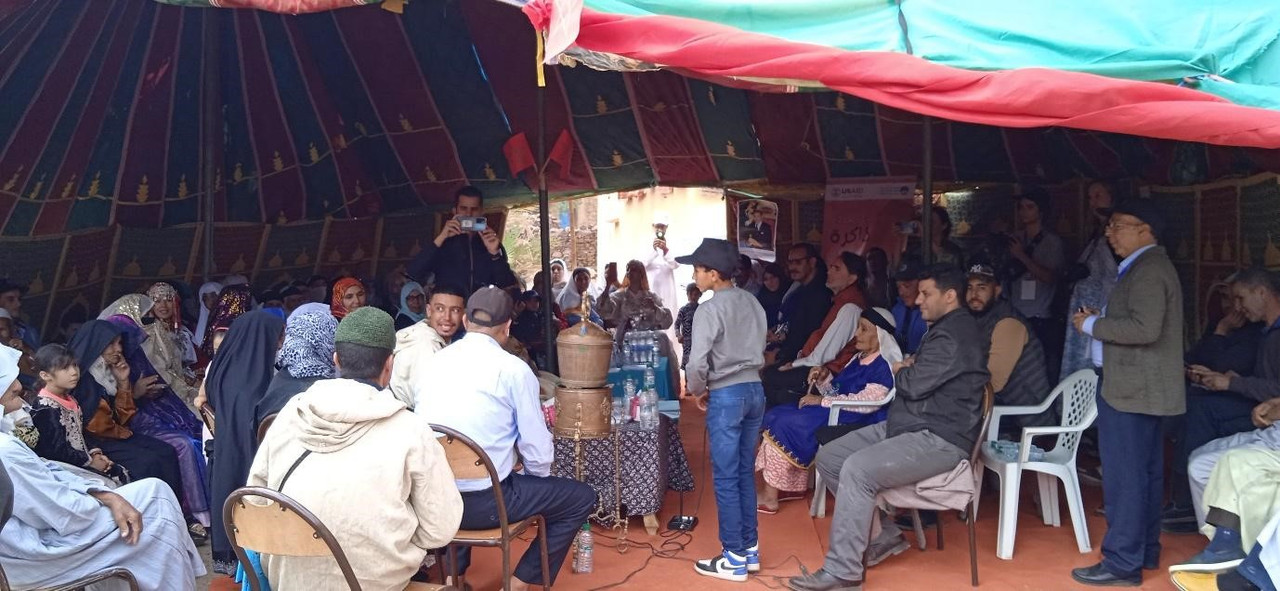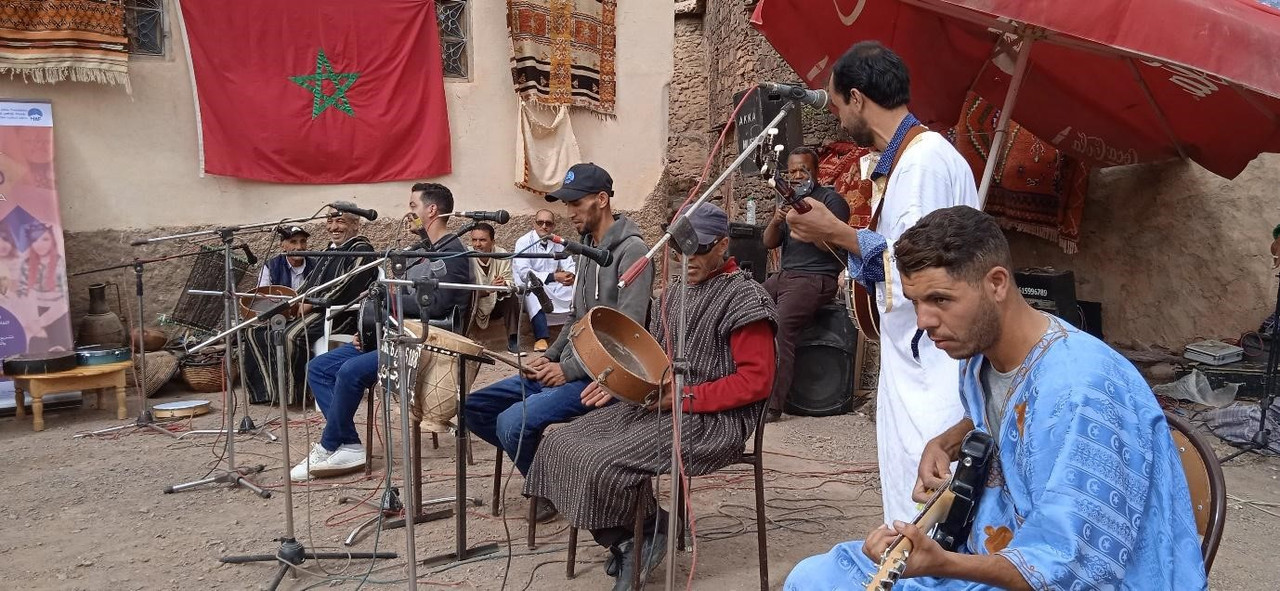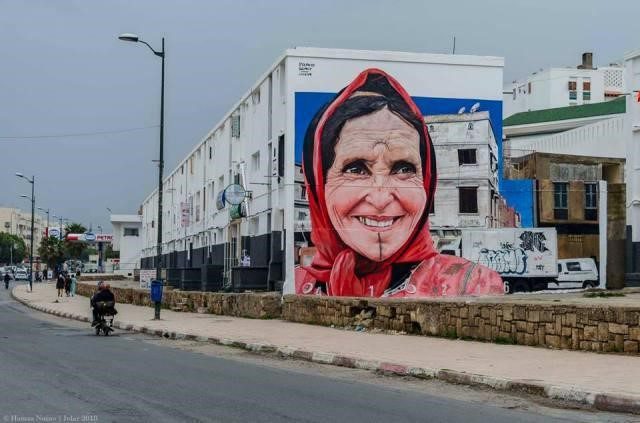Arabic Version
By Jamal Maghiouzi, Dakira Cultural Coordinator
Internationally, December 20 is a day to celebrate human solidarity. This concept has been deeply rooted in the heart of the United Nations since its formation. At the High Atlas Foundation, we identify with the principles of unity, diversity, and solidarity, as they are embodied by the people and the official priorities of the Kingdom of Morocco. HAF is proud to implement programs that promote human solidarity and social harmony. Chief among these is the USAID Dakira program. In commemoration, Dakira Cultural Coordinator Jamal reflects below on how solidarity in the past among Muslim and Jewish people in Tanamert has helped shape more inclusive communities in the region.

Traditional Ahwach is performed with community members in Tanamert. Photo: Jamal Maghiouzi/HAF
Between September 28 and October 3, 2022, the High Atlas Foundation engaged seven communities in southern Morocco in cultural dialogue celebrations during which local elders recounted memories and stories from their lives, younger generations contributed their own questions and experiences, and community partners highlighted local lore expressed through music, dance, and food. The tour was organized as part of the USAID Dakira program. On Saturday, October 1, it stopped in Tanamert, one of the villages in the Taroudant province, where I have lived and worked collecting and resharing the multicultural ‘dakira’–the memory–of the place and people for a year.
On this day, the HAF-Dakira team, Ikiwa Association of Tanamert, Tizninit Cooperative of Tafngha n Barka, Former Students of Alarak High School Association in Ighram circle, members of the Students’ Parent Association, the students from Alarak middle and secondary school, and a group of Imarjane musicians gathered together and contributed uniquely to this cultural event. Local community members from several villages, including Tafngha n Barka and Tanamert, Tiflsine, Aniloul, Ighram, Aguered, Iguafaine, Ighil n Ismsed, Aman Tazart, Tafngha, Aqqa, Ifsfas, Tighmi n Tizint, and Du Asawn joined. The turnout was incredible at 143 people–73 men, 60 women and 29 youth–even though only 80 had been expected to attend.
Roots and Memories: Da Hassan’s Mother
Da Hassan Srayhe, whose family I’ve come to know over my tenure with Dakira, shared with me that though they now live in Tafngha n Bark, where his father is from, his mother was born and raised in Tanamert, the village where we were. She said she missed the time of her childhood there, which she enjoyed very much, and was always eager to visit her parents’ home in this special place and cook meals for them.
Da Hassan’s mother along with a number of other women from the community had previously received the HAF-Dakira team in Tafngha n Barka during a cultural visit in late July. They had then participated in a series of workshops, including a women’s empowerment workshop as well as a community dialogue and story-sharing event about the Jewish communities. One of the women, Massa Houriya, had emotionally remarked during these engagements, “We wish we could always have you teaching us new things like these.”
On the day of the dialogue event, Da Hassan’s mother got up around the time of Al-Fajr, the morning prayer, and prepared traditional barley soup, bread, and spiced coffee with local herbs for her family. She fed her chickens, goats, and cow. Then, she saddled her donkey and loaded everything she needed to cook the couscous meal in Tanamert. Despite the half-hour journey, she managed to arrive there before the HAF-Dakira team, who drove in from Taroudant. During the event itself, she multitasked, keeping an eye on the couscous as it cooked while also being present in the tent for the dialogue activity.
Meeting the Community: Stories, Tizrrarin, and Ahwach
Upon the arrival of the HAF-Dakira team, they shared breakfast with the villagers of Tanamert and Tafngha n Barka in tamsriyt, the guest room, before joining everyone in the tent. Local women immediately started singing together, each taking a turn for a solo performance. Men also took part in this, particularly some local poets: Da Omar, Da Mohamed, Da Moubark, Da Zakaria, Massa Fadim, Massa Fadim, Massa Zahra, Massa Sultana, Massa Fadma. We also ended the special event with more music performed by Imarjane, and Ahwash was performed by the community members, who included the HAF team in their celebration.

Heritage dialogue tent with local community members in Tanamert. Photo: Jamal Maghiouzi/HAF
Let us remind ourselves that before the invention of writing, people communicated orally for many centuries. Amazigh people still largely produce oral poetry and sing together. The poets get their inspiration from the audience within their communities. At the event, the community members expressed their greetings, welcome, celebration and thanks through what are called Tizrrarin in Tachelhit. It is one of the Amazigh literature genres; people sing it at social occasions like wedding ceremonies. It can sometimes take the form of a dialogue between the poets about the topics of thanking, flattering, and flirting in public space and in front of relatives and friends. The poets comfortably use similes, using imagery such as flowers (Ajdig), horses (Ayyis), sun (Tafoukt), stars (Itri), bees (Tazwit), gazelle (Azngd) and birds (Aylal) to describe the beauty of the girls.

Circle of Ahwash in Tanamert. Photo: Jamal Maghiouzi/HAF
In her research, Massa Rachida explored the relationship between women and Amazigh poetry in the villages of Ighram circle. Rural Amazigh women are the powerhouses of local communities. Every day, they work hard to keep their households running while performing other outdoor tasks, such as engaging in agricultural activities and herding. These are two serious responsibilities that fall on the shoulders of rural Amazigh women, leaving them without enough time to care for themselves. Nonetheless, rural Amazigh women gather in Asarag, the common meeting space, to chat, dance, and sing Tazrrart poems. Their beautiful singing attracts and surprises their audiences because it comes from their hearts. Through such poems, they express their sadness over the everyday challenges they face to cope with the reality of their responsibilities and unknown future.

Imrjane cover band in Tanamert. Photo: Jamal Maghiouzi/HAF.
The HAF-Dakira team and the attendees enjoyed the local, authentic singing and dancing performed by women, men, and youth. We also facilitated a workshop of story-sharing about the traces of the Jewish communities in the area and the stories of how locals remember them.
Massa Rachida shared with us her grandmother’s story with the Jewish community in Ighrem and Irazane. Her grandmother is now 86 years old. Decades ago, she lived with members of the Jewish community who were visiting Ighrem for trade. Her father lived in Aguerd village, which is not far from Ighrem’s weekly market. He was selling silver and fabric, and he exchanged with many Jewish traders from Tahala and Idda Ousmlal. He once hosted a very nice, skilful Amazigh Jewish tailor named Hnni in his home for over three months. Rachida’s family provided him with unleavened bread, eggs, tea, butter, water, and utensils for cooking because he did not eat their food. They also saw how he was praying against the wall, but they never understood what he was reciting. Hnni would go back to his work after the prayer, and he would wash his clothes and clean his room himself. Rachida’s grandmother recalls Ben Ija, Ben Hayyoun, and Ben Sthila, who used their donkeys and lorry trucks to distribute and collect items. They frequently came to Ighrem to sell silver, olive oil, candles, and other items that local people needed in their daily life.
Da Hassan is in his late 60s, and he is from Tanamert. His first job was herding sheep and goats with his father. Around the age of 16, he went to Fes to work in a shop. When he had acquired notable experience, he opened his own shop in Meknes. He managed to take his small family there, and he supported and encouraged his children to study. Like others, he accepted the invitation to attend the heritage dialogue event in Tanamert. He shared with us his story with a Jewish trader in Meknes whose name was Tolidano. Da Hassan once borrowed money from him, but when his friend later closed his shop, Da Hassan stopped seeing him. He became concerned and continued to look for Tolidano, eventually encountering someone who led him to the synagogue where Toledano would pray. Not realizing it was prayer time, Da Hassan went there looking for his friend. For the first time, he saw how the Jewish people pray. It was a relief for him to meet his friend again and pay back the money he had borrowed from him. He couldn’t imagine remaining indebted to his Jewish friend.
Building Capacities, Sharing Identity
Parallel to the activities on that day, the HAF team conducted a historical and cultural site documentation training with four youth from Tanamert and followed up with Tiznint Cooperative members, who had previously participated in the Imagine women’s empowerment workshop with HAF, to support them toward a common goal of a tree nursery in Tafngha n Braka. Some members of the community also recorded video testimonials, expressing what Tamghrabit, or ‘Moroccanness,’ means to them.
—-
Jamal Maghiouzi is a Dakira Cultural Coordinator and is currently based in Taroudant. The USAID Dakira program, implemented by the High Atlas Foundation and its partners, aims to strengthen inter-religious and inter-ethnic solidarity through community efforts that preserve cultural heritage in Morocco.
This article was completed with the support of the United States Agency for International Development (USAID), and the High Atlas Foundation is solely responsible for its content, which does not necessarily reflect the views of the USAID or the Government of the United States.








